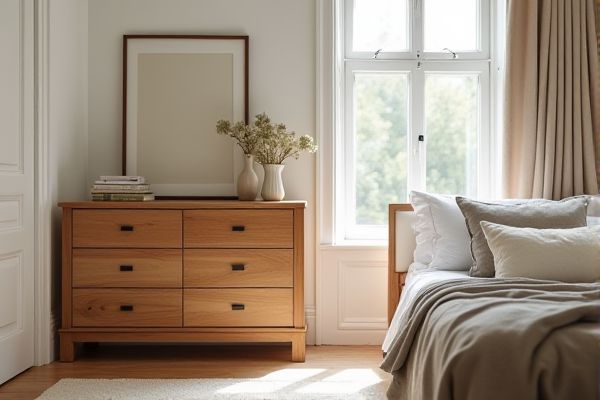
A chest of drawers typically features a taller, narrower design with multiple drawers stacked vertically, ideal for maximizing storage in compact spaces, while a dresser is usually wider and shorter, providing both drawer storage and a surface for decorative items or a mirror. Understanding these differences helps you choose the best option for your bedroom organization needs; read on to explore detailed comparisons and tips for selecting the right furniture piece.
Table of Comparison
| Feature | Chest of Drawers | Dresser |
|---|---|---|
| Design | Tall, vertical structure with multiple drawers stacked | Wide, horizontal with drawers and often a mirror |
| Function | Storage for folded clothes and small items | Storage plus often used as a vanity with mirror |
| Size | Taller and narrower, saves floor space | Lower and wider, requires more floor space |
| Usage Location | Bedrooms with limited floor space | Bedrooms or dressing rooms, often near mirrors |
| Typical Materials | Wood, metal, MDF | Wood, MDF, sometimes with glass mirrors |
| Additional Features | Mostly drawers, minimal surface area | Drawers plus top surface for decor or dressing |
Introduction: Chest of Drawers vs Dresser
A chest of drawers typically features a tall, vertical design with multiple stacked drawers, optimizing storage in compact spaces. Dressers often have a wider, lower profile with a variety of drawer sizes and sometimes an attached mirror, making them ideal for bedroom organization and grooming. Both furniture types serve storage purposes but differ in form and functionality to suit varying needs.
Definition and Key Differences
A chest of drawers is a tall, narrow piece of furniture primarily designed with multiple stacked drawers used for storing clothing, while a dresser is typically wider and lower, often featuring a combination of drawers and a mirror for both storage and personal grooming. Key differences include their dimensions and functional design: chests optimize vertical space with more drawers, whereas dressers provide a broader surface area and often incorporate mirrors for bedroom use. The distinction impacts room layout and user preference depending on space availability and intended use.
Design and Structure Comparison
A chest of drawers typically features a tall and vertical design with multiple stacked drawers, optimizing space efficiency in smaller rooms. Dressers are generally wider with a lower profile, offering a flat top surface for additional storage or decoration. Both furniture pieces vary in drawer depth and height, affecting their functionality and placement within a bedroom.
Storage Capacity & Organization
Chest of drawers offers a taller design with multiple deep compartments, maximizing vertical storage capacity for items like folded clothes and accessories. Dressers typically provide a wider surface area and shorter height, allowing for both drawer organization and space to display or arrange personal items on top. Your choice depends on whether you need more vertical storage or a combination of drawer space and surface for organizing essentials.
Space Requirements and Room Placement
Chest of drawers typically requires less floor space due to its vertical design, making it ideal for smaller rooms or tight corners. Dressers, with their wider and lower profile, demand more horizontal space but offer a larger surface area on top for decorative items or daily essentials. Your choice between the two depends on the available room dimensions and how you plan to position the furniture for easy access and aesthetic balance.
Style Variations and Aesthetic Appeal
Chest of drawers typically features a vertical structure with multiple stacked drawers, offering a sleek and space-efficient design that suits modern and minimalist styles. Dressers often present a wider, horizontal form with a combination of drawers and a surface for decor, lending a classic or rustic charm that enhances bedroom aesthetics. Both furniture pieces adapt to various materials and finishes, allowing customization to match diverse interior design themes and personal preferences.
Functional Use Cases
Chest of drawers typically offers vertical storage with multiple deep drawers ideal for organizing clothing, linens, or accessories in compact spaces. Dressers often combine wider, shallower drawers with a flat top surface, providing both storage and a display area for personal items or decor. Both furniture pieces serve to enhance bedroom organization but differ in drawer layout and surface usability to meet varied functional needs.
Pros and Cons of Chests of Drawers
Chests of drawers offer compact storage with a vertical design ideal for small spaces, featuring deep drawers that accommodate bulky clothing and linens efficiently. However, their narrow footprint can limit surface area for display or organization, and the height may pose accessibility challenges for shorter individuals. Constructed for durability, chests often provide a more stable structure compared to dressers, but may have fewer drawers, reducing storage segmentation options.
Pros and Cons of Dressers
Dressers offer ample storage with multiple drawers that help organize clothing efficiently, making them ideal for bedrooms with limited closet space. Their flat top surface is useful for displaying personal items or placing essentials within easy reach. However, dressers can be bulky and heavy, requiring more room and effort to move compared to other storage options like chest of drawers.
Choosing the Right Option for Your Home
Selecting between a chest of drawers and a dresser depends on space availability and storage needs; chest of drawers typically features a tall, vertical design with multiple deep drawers, ideal for narrow rooms, while dressers are wider with a combination of drawers and often a large top surface suited for bedrooms. Consider the style and function: dressers provide ample surface area for decorative items or a mirror, enhancing bedroom organization, whereas chest of drawers offer concentrated drawer space for clothing or accessories. Measuring your room dimensions alongside your storage requirements ensures the chosen furniture piece complements both your aesthetic preferences and practical use efficiently.
 homyna.com
homyna.com